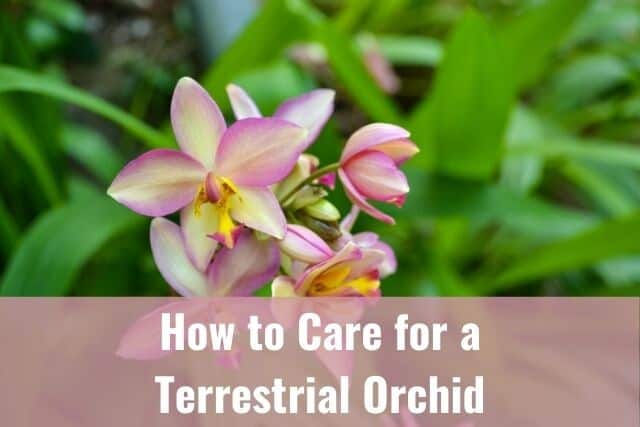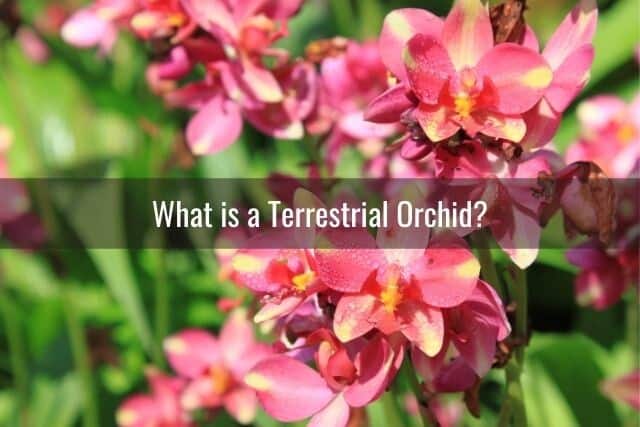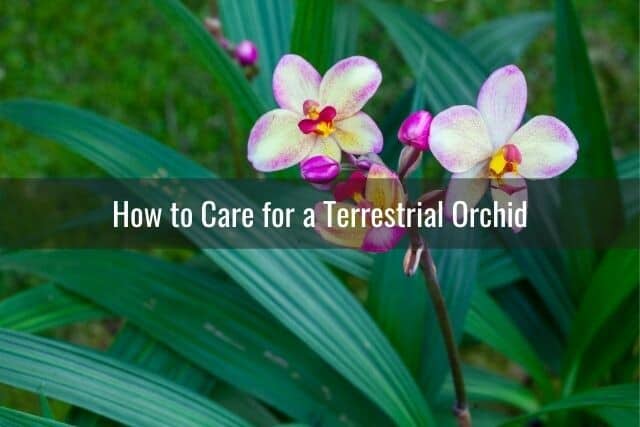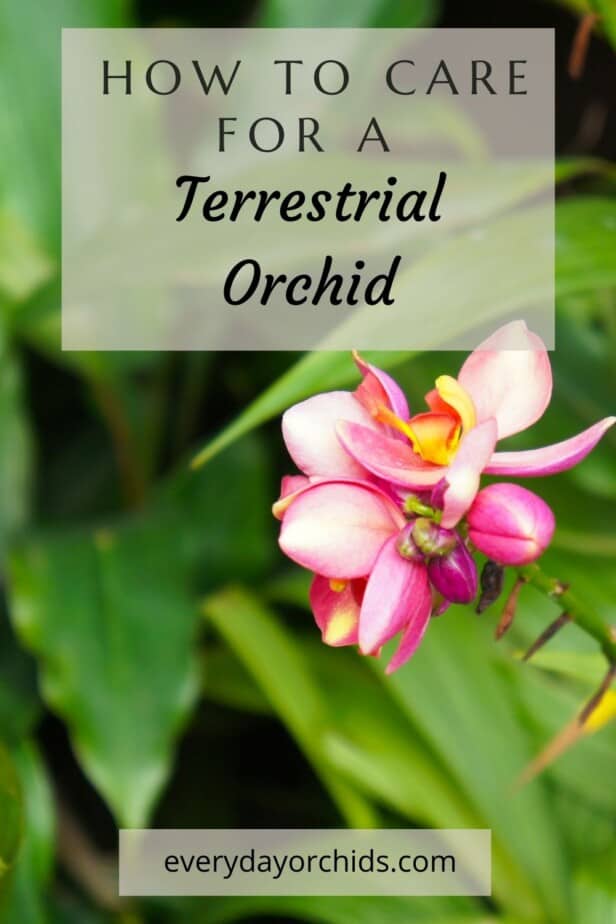Some of the most popular orchids out there are terrestrial orchids. This is amazing, because when you think about it, terrestrial orchid species make up just a tiny fraction of all the orchids out there in the world. There are thousands of different orchid species in existence. Of these thousands, a little more than 200 of these species are terrestrial orchids.
Terrestrial orchids can make a beautiful addition to any garden. Have you ever wanted to grow these orchids yourself and wondered how you should care for them? Well, look no further!

Basic terrestrial orchid care is very similar to orchid care for epiphyte orchids. However, there are some key differences in watering, temperature tolerance and fertilization needs. Unlike epiphytic orchids, whose roots absorb nutrients and water from the air, terrestrial orchids are ground-loving plants. They receive their water and nutrition from the potting media or soil. Some of the more popular terrestrial orchid varieties include the Cymbidium and Lady Slipper orchids.
I will go over the unique differences and care needs of terrestrial orchids in more detail here. Keep reading to learn more about the some of the more popular terrestrial orchids. I’ll go over how to care for terrestrial orchids below.
Please note that these links are affiliate links and as an Amazon Associate, I earn from qualifying purchases. Purchases made through affiliate links in this post may generate commissions at no additional cost to you. Use this link for a discounted Amazon Prime trial. Thank you for your support!
Table of Contents
What is a Terrestrial Orchid?

A terrestrial orchid is a ground orchid. You can grow your terrestrial orchid in a pot or as part of your container garden. If you live in a mild climate, you can plant these orchids directly into your garden. Many varieties can be grown outdoors year-round depending on where you live.
These orchids can handle cold temperatures more readily than epiphytic (tree-growing) and lithophytic (rock-growing) orchids. This ability to handle cold makes terrestrial orchids a hardier orchid for your outdoor garden. Some terrestrial orchid varieties even require sub-freezing temperatures to trigger blooming.
Most terrestrial orchids generally become dormant in the cold winter months. Like many other plants, they will grow and bloom in the spring when the weather warms up again.
Unlike their epiphyte counterparts, terrestrial orchids do not have aerial roots. Instead their roots are all hidden beneath the potting media or soil, much like a “normal” plant.
How to Care for a Terrestrial Orchid

Caring for a terrestrial orchid is in many ways, similar to caring for any other orchid. You may already be familiar with how to care for a Phalaenopsis orchid, which is an epiphytic orchid. Many of the same principles with watering and lighting will also apply to a terrestrial orchid.
Lighting
If you are new to growing terrestrial orchids, start by growing your orchid in a container or a pot. That will give you some flexibility in whether you keep your orchid indoors or outdoors. You can move your orchid around based on the season and outdoor temperatures.
If you prefer to keep your orchid outdoors, keep it in an area protected from wind, rain, and direct sunlight. Place the orchid in a location where it can receive bright, indirect or filtered light throughout the day.
Depending on the species of orchid, some orchids may be able to tolerate full sunlight, while others prefer partial shade. For more information, check out this Everyday Orchids guide on orchids and light.
Much like any other orchid, you want to ensure that your orchid is protected from direct sunlight. This will prevent sunburn and leaf damage. To know if your orchid is getting enough light or too much light, look at the orchid’s leaf color. An orchid’s leaf color can tell you a lot about the condition of the plant, including if it is getting the right amount of light. You want to aim for a grassy green color in your orchid’s leaves.
Temperature
If you would like to keep your terrestrial orchid outdoors year-round, you need to know what kind of climate you live in. Choose an orchid that is best suited for that climate and seasonal temperature changes.
Some terrestrial orchids require exposure to freezing temperatures to trigger blooming in the spring. Other terrestrial orchids will show signs of cold or frost damage if left outside during the winter.
Cypripedium orchids, or “Lady Slipper” orchids, can tolerate cold temperatures and even frost. This makes Lady Slipper orchids a great option if you live in a region that experiences cold winters.
My article about how to winterize your orchids is a good resource on how to prepare your orchids for winter. You can also read about how to care for your orchids outdoors. You’ll be able to get an idea of which orchids are best suited for outdoor living.
If you are unsure if your orchid can handle the fall and winter temperatures in your area, keep your orchids in containers or pots. A wheeled plant stand such as this one or this heavy-duty plant stand can go under your orchid pots. That way, you can easily and quickly move your orchids indoors once the temperatures start to drop. Read more about when to move outdoor orchids inside here.
As I alluded to above, the temperature tolerance of terrestrial orchids varies according to the species. This is very important to keep in mind when you are trying to figure out what orchid to buy. Knowing the temperature tolerance of your orchid species will help you know how to care for your orchid.
Watering, Soil and Fertilizer
Whether you plant your terrestrial orchid in a pot or in the ground, you will need to use well-draining orchid potting media to prevent root rot. Even if you are planting your terrestrial orchid in the ground, you do not want to use regular soil or regular potting mix!
Instead, use a mixture of orchid potting media and soilless potting mix. Examples of soilless potting media are sphagnum moss, perlite, peat moss, gravel, lava rocks, vermiculite, coarse sand and coconut fiber. Perlite and sand do not degrade over time. When mixed with orchid potting media, these soilless components allow you to stretch out the repotting intervals for your terrestrial orchids.
Repotting Your Terrestrial Orchid
Some terrestrial orchid roots prefer not to be disturbed with yearly or even every other year repotting. Therefore, use a potting mix combination that includes inorganic material which doesn’t break down. If you do need to repot your orchid, wait until after the blooming period has finished and then repot.
To start, you can create a potting mix for your terrestrial orchid. Use a combination of equal parts orchid potting mix, sand, and a couple of other types of soilless potting media. Examples of soilless potting media you can use include sphagnum moss or perlite. Be sure you use a fine-grade orchid potting mix. This is most suitable for terrestrial orchids. The smaller pieces of bark in the fine-grade mix will allow for more moisture retention.
If you know what kind of terrestrial orchid you have, you can figure out if your particular orchid prefers more or less moisture. You can also determine if it comes from a wetter or drier climate and create your potting mix accordingly. For example, incorporating material such as gravel and lava rocks will create a drier soil environment. Using sphagnum moss or peat moss will create a wetter environment.
If you prefer, you can also buy a pre-made potting mix specific to your orchid. You can get something like this one made specially for Cymbidium orchids. Whatever potting mix you use, make sure that it is airy and will allow the water to freely drain. You want to allow for the roots to breathe a little. Let the potting media or soil to dry out between each watering. This is very similar to how you would water an epiphytic orchid.
Fertilizer
Terrestrial orchids do not need much fertilizer. You can use a quarter-strength orchid fertilizer solution to feed your plants during their growing period. Some orchids, such as the Cypripedium “Lady Slipper” orchid, require even less fertilizer. Therefore, it is important to check the specific needs of your orchid first. Too much fertilizer can be detrimental to your orchid.
If you would like to learn more, check out this guide on how to fertilize orchids.
Propagation
Propagating terrestrial orchids is usually done by dividing the pseudobulbs. I provide step-by-step instructions on how to divide the pseudobulbs and propagate new orchids in another Everyday Orchids guide. Be sure to check that out if you would like more guidance on propagating your orchid plant.
Some terrestrial orchids species can be propagated through keiki growth instead of pseudobulb division. You would need to use an orchid cloning paste to trigger keiki growth in the orchid. Whenever you have keiki growth on your orchid, it is important to leave it on the mother orchid. Allow it to continue to grow. Wait until the keiki has roots that are at least 2 inches long and at least two leaves before you attempt to separate it from the mother plant.
Again, check out my article about propagating orchids. In that article, I also outline the proper way to separate a keiki from the mother orchid. You definitely do not want to just pull it off the mother plant! I also provide more details there on how to pot the newly propagated plants and how to care for them.
Popular Terrestrial Orchids

Some of the more popular terrestrial orchid varieties include the Cymbidium, Spathoglottis, Bletilla, Calanthe, and Cypripedium orchid species. This table below summarizes the main points of what you will need to know about each species.
| Orchid Species | Temperature Tolerance Range | Lighting Tolerance | Watering Needs | Fertilizer |
| Cymbidium | 50-85 degrees Fahrenheit, USDA zone 10 to 12 | Partial sun. Full sun fine in cool climates | Frequent watering during growth periods | Regular fertilizer during growth period |
| Spathoglottis | 60-80 degrees Fahrenheit, USDA zone 11 | Partial shade to full sun | Water when top layer of soil is dry | Regular fertilizer with high nitrogen fertilizer |
| Bletilla | 10-75 degrees Fahrenheit, USDA zone 6a to 9a | Partial shade, filtered light | Water once a week when new shoots appear, do not water when dormant | Fertilize once a month with a balanced orchid fertilizer |
| Calanthe | USDA zone 7 to 11 (zone 6b ok with mulch) | Partial shade | Water once a week when new shoots appear | Fertilize once every two weeks with a balanced orchid fertilizer |
| Cypripedium Lady Slipper | Varies depending on species, but many can survive in USDA zones 2 to 5 and zone 6a | Filtered light, partial shade | Soak when watering. Allow soil to dry out between waterings | Fertilize just once every two weeks during growing season |
Final Thoughts
There are many varieties and species of terrestrial orchids available. Terrestrial orchids can be a great addition to your orchid collection and garden. Now you know about basic terrestrial orchid care and have a good start for your terrestrial orchid garden. You’ve also gotten an overview about the growing requirements for five popular terrestrial orchid varieties. I hope that this helps you as you learn to care for your orchid!
If you enjoyed this article, please pin it and share!


